Denver, Colo., Jun 15, 2024 / 06:00 am
About halfway through the western route of the National Eucharistic Pilgrimage, the Perpetual Pilgrims took a quiet respite from the road on Saturday, June 8, to attend an age-old Byzantine Catholic Divine Liturgy in Denver.
Day-to-day, the perpetual pilgrims make their way across the U.S. by walking and driving, sometimes in a procession of cars, with the monstrance holding the Eucharistic Lord in the mobile chapel.
In addition to their frequent stops at parishes, processions, and service activities, the pilgrims spend much of their time in adoration as the van drives across the country. The Junipero Serra Route began on the coast of California on May 18 and is set to reach Indianapolis in mid-July.
When they reached Holy Protection of the Mother of God Byzantine Catholic Church, the pilgrims stood with other parishioners and attendees on the rugs laid across the wood floors of the small church, listening to the chant and song.
Unassuming on the outside, the humble but beautiful interior is covered with golden icons and blanketed with detailed rugs for parishioners to stand on and sit during the homily.
The pilgrimage so far
Jack Krebs, one of the Perpetual Pilgrims, said he joined the pilgrimage because he wanted to share Jesus in the Eucharist.
When asked what his daily life looks like as a pilgrim, he said it varies a lot, depending on the day, the parish, and the diocese.
“But generally, it will be Mass in the morning and then a quick procession, and then we’ll drive, and we’ll have a driving procession,” he said. “Sometimes it’s with cars following. Other times it’s just having adoration in the van.”
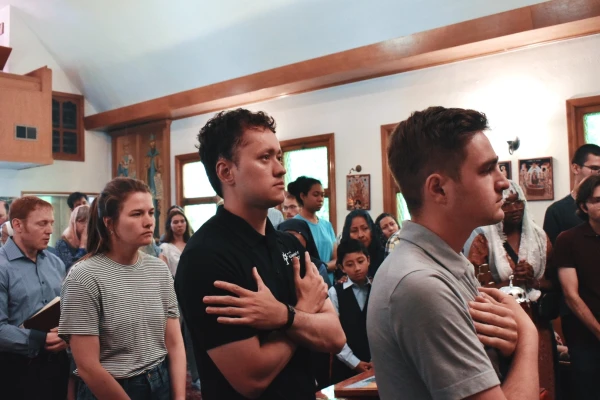
Krebs said it can be difficult to stay focused depending on where they are driving.
“Through the mountains and through the very beautiful areas, it’s easy to make that your prayer as you’re driving through and reading some of the Psalms,” he said. “It’s really easy to reflect in that way.”
“But there’s other times where you’re just driving through a city and there’s just so much distraction and ads and all this stuff,” he continued. “But it’s also unique because Jesus gets to just bless that place as you go.”
“If he’s really present here, then he will impact all these people,” Krebs continued. “I almost see it as Jesus walking around in Galilee, just laying his hands on people’s heads and blessing them whenever they encounter him.”
During the pilgrimage, Krebs said he has been taking inspiration from both the Psalms and the Gospels.
“The Gospel [stories] of Jesus walking around have been very profound because we’re living that — just walking around with Jesus,” he said. “Some people look on and are very struck. Some people think it’s weird.”
(Story continues below)
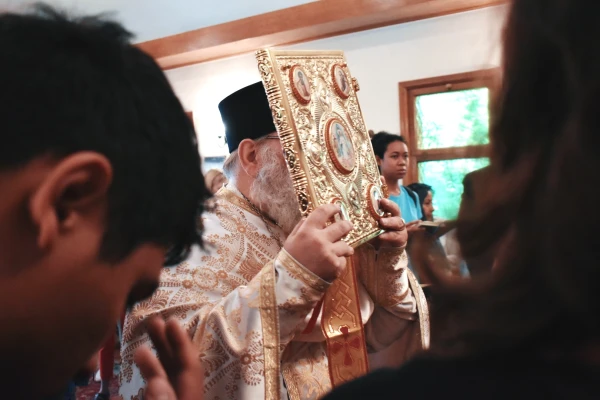
“I feel like I’m in a way filling that role similar to what the Apostles did, of just walking along and bringing Jesus to the people,” he explained.
“I think the other thing is Jesus has reminded me that it’s not on me as a pilgrim to fix people. It’s not on me to carry this movement,” Krebs said. “It’s just on me to bring the people to him and bring him to the people and just let him do the heavy lifting, and let him take care of it.”
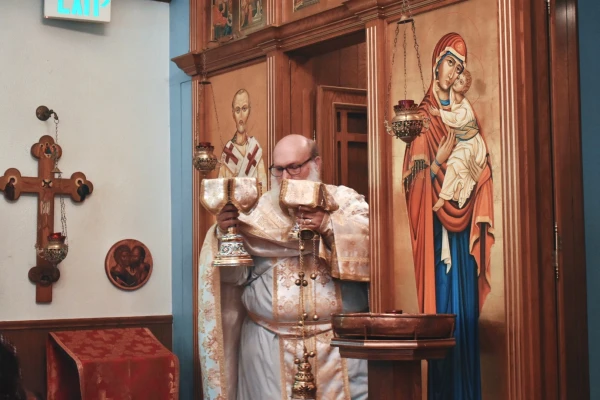
The pilgrims not only spend a lot of time with Jesus but also with each other. Krebs said they are being more intentional about one-on-one time to help form deeper friendships.
Byzantine liturgy
Attending a Byzantine Catholic liturgy for the first time is very different from the Roman Catholic Mass, starting with the lack of pews.
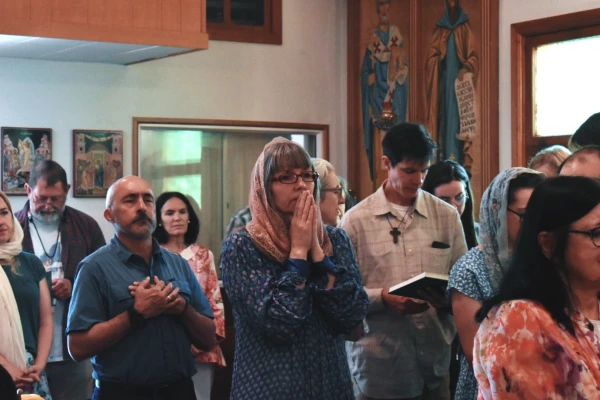
“I think [of] what Father said in the very beginning of the sacred liturgy, ‘If this is new to you, just let it wash over you,’” Krebs recalled. “I really like that he said that because it gave me a context in which to approach this.”
The Mass, called a Divine Liturgy, involves multiple processions around the crowded room with incense. Many parishioners will make the sign of the cross and a low bow, sometimes touching the floor. The Eucharist is given via intinction, where the small cubes of consecrated, leavened bread are placed in the chalice and given on a spoon.
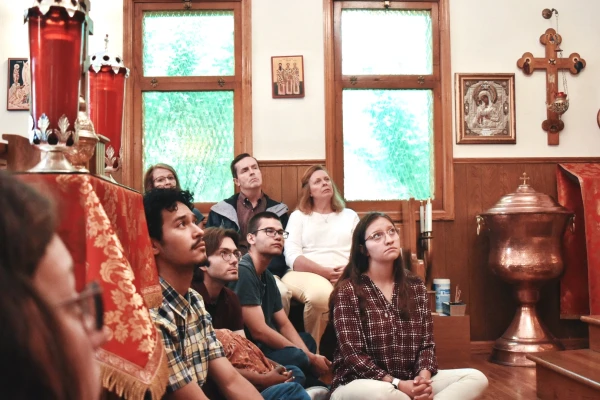
Young kids are invited to stand in the front while the priest reads the Gospel, and during the homily attendees sit crisscrossed on the ground while pews line the walls for those who need them.
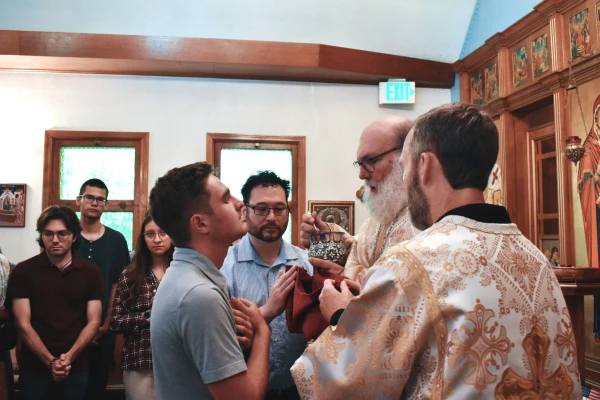
“I sat there and let the beauty of it wash over me and tried to be present to the beauty of the icons and the church architecture,” Krebs said.
Nature and God
Krebs, originally from Wisconsin, studied environmental science at the University of Nebraska. He went on the national pilgrimage after first hearing about it from a friend.
“I think it just made my prayer become a lot more relational,” he said of the Eucharistic Revival. “I’ve been coming to know the gift of the Eucharist is a lot deeper.”
After the pilgrimage, Krebs will be working at Annunciation Heights, a program that runs outdoor Catholic camps for youths, families, and students in Estes Park, a town in the Colorado Rockies.
“I studied environmental science and water science in college, so praying or being close to the Lord in creation, or coming to know our Creator through that has been powerful,” he said.
Krebs mentioned taking inspiration from Psalms 121 and 122, which are the psalms that people would pray when making pilgrimages to Jerusalem.
“[We’re] driving through the mountains and one of the Psalms uses the imagery, as the mountains surround Jerusalem, so God’s love surrounds you,” he recalled. “And we’re driving through this canyon, and I’m thinking, if these mountains, if these rocks are God’s love, I’m just so safe here. Nothing can hurt me down here. It’s just so beautiful and you feel safe.”
Krebs shared another reflection that the pilgrimage has inspired, noting that images from the Psalms help convict him “of the deeper truth of God’s love, or his care for us, or his mystery, his grandeur, his smallness — all of it.”
“Because even as I’m driving by and I see this one little flower in the middle of the pasture, God knows that that flower is there, and he willed that that flower was there, and that flower is just glorifying him in its smallness,” he continued. “It’s going to live for a year, and then it’s going to die, and no one’s going to know about it — but God cares so much about the small things.”
“And then I think also going through the cities where there’s more people, I think the image is Jesus is able to look on all these people and see them and bless them,” he continued. “Not that he doesn’t see them [already], but he’s being made physically present here because in such a real way.”







